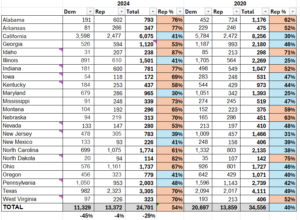Election Day is on November 5, which seems like the distant future (for one thing, only 25 states have even held their primaries as this article is being written), but with the major party’s nominees’ essentially being determined several months ago, now is the time to begin the discussion about the upcoming Presidential election season and its associated political atmospherics, as this “background noise” creates the climate President Biden faces in his re-election effort.
Voter registration data
In 30 states, voters register by party. Over time, party preferences of voters can change, either due to (1) changes in political attitudes, or (2) newcomers’ bringing in a different set of political attitudes. To use Louisiana as an example of the former concept, just 10 years ago, Democrats had a 19-point edge (47-28%, or 566K) in voter registration, while as of June 1, 2024, that Democratic plurality considerably has narrowed over time to just four points (38-34%, or 111K).
At the national level, a variation of that has happened in the 30 states that register voters by party. Since the 2022 midterms, Democrats have in both absolute numbers and in percentage terms lost strength, while Independent/Unaffiliateds/3rd party voters have been the primary beneficiary. More specifically, a Democratic midterm edge of 9 points (38.9-29.9%) over Republicans has shrunk to 7.5 points (37.7-30.2%). If we were to expand our “lookback period” all the way back to the inauguration of President Biden, the slippage between 2021 and now is even greater: in February 1, 2021, Democrats had a voter registration edge of 10.2 points 40-29.8%) over Republicans. To put these changes in numeric terms, since Biden became President, his party has LOST 3.4 million members, while Republican registration has made small gains, and 1.8 million more voters have become unaffiliated/Independent/3rd party.
Primary voting data
JMC has since 2008 been of the opinion that external data points like (changes in) partisan voter registration and partisan primary turnout provide important clues as to the November outcome. That is how he foresaw months in advance (to use three examples) the Republican landslides in 2010 and 2014, as well as the eventual Democratic landslide in 2018.
As this article is being written, only 25 states have held their primaries, but in the opinion of the author, 25 states is a sufficient amount of partisan data to get a feel for voter enthusiasm this year. There is a caveat to this analysis: since the Presidential election cycle concluded fairly quickly on the Republican side, and the Democratic primary challengers to President Biden never really attracted the imagination of Democratic primary voters, JMC is restricting his analysis ONLY to states where Congressional and/or local offices were on the primary ballot, with comparative statewide turnout numbers for both parties for both 2020 and 2024. From an examination of the data, several points are immediately apparent: (1) primary turnout is down relative to 2020, and (2) the drop in turnout is more pronounced on the Democratic side (i,e., 45% fewer Democratic primary voters, vs. 4% fewer Republican primary voters). What this means in plain terms is that from the data, Democratic enthusiasm isn’t at its 2020 level of intensity, and at the present time, JMC believes November turnout will NOT reach the record high that was attained in 2020.
Polling data
Before there can be any discussion of polling in a Presidential contest, it’s important to understand the atmospherics an incumbent running for re-election is facing. In Joe Biden’s case, his approval ratings have been “underwater” for some time (according to 538, he hasn’t had positive job approval since September 2021). Currently, his approval ratings are abysmal, regardless of which site is used to compile polling data: Real Clear Politics shows his disapproval at 56-40%, while 538 shows an even more abysmal 56.5-38% disapproval. That one number explains why, despite government statistics showing low unemployment and supposedly an “era of good feelings”, Biden is not showing any signs of electoral dominance. In fact, 538 shows Donald Trump ahead 41-40% (with 9% supporting Kennedy), and Real Clear Politics’ polling average shows Trump up half a point (45.2-44.8 for Biden).
Did President Trump’s conviction on May 30 move the poll numbers ? Minimally. The poll average on May 30 showed Trump ahead by 1.7 percentage points. The polling average as of today shows his lead was trimmed by 1.3%, which is insignificant when you consider that (1) he is the first current or former President to be convicted, and (2) the election is nearly five months away.
Not “Election DAY”, but “Two months of Election Days”
And finally, when discussing the atmospherics of Election Day, it’s important to appreciate the “front loaded” timing of “early voting season” in the following ways: (1) more people are choosing to vote BEFORE Election Day (46% in Louisiana voted before Election Day in 2020, while 73% did nationally), (2) with voters being more likely to vote early, more states are accommodating this “increased market demand” by offering voting that starts early in September (North Carolina sends out mail ballots on September 6, while in person early voting starts in Minnesota, South Dakota, and Virginia on September 20). Given the sheer volume of voters choosing to vote early (even in the 2022 midterms, only 43% voted ON Election Day), “late breaking” campaign developments likely will not have the impact they may have had in the past.
Conclusion
Given the context of external data from polls, voter registration, and primary participation, President Biden has his work cut out for him, and the changed environment for when voters CAN cast ballots means that the “election season” will be more compressed than in previous election cycles.



